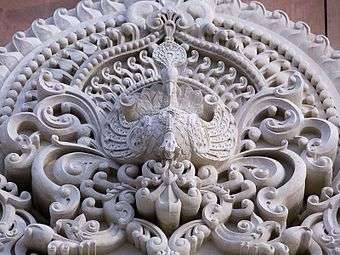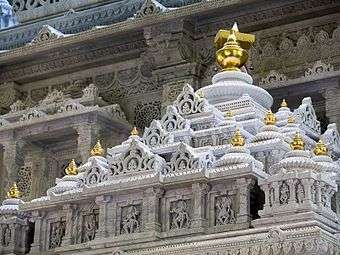Akshardham (New Jersey)
| Akshardham | |
|---|---|
 | |
| Name | |
| Proper name | Swaminarayan Akshardham |
| Devanagari | अक्षरधाम |
| Geography | |
| Country | United States |
| State | New Jersey |
| Location | Robbinsville |
| Culture | |
| Primary deity | Swaminarayan |
| Architecture | |
| Architectural styles | Vastu Shastra and Pancharatra Shastra |
| Inscriptions | Spiritual-Cultural Complex |
| History and governance | |
| Date built | 2014 (estimate) |
| Creator | Pramukh Swami Maharaj |
| Website | www.baps.org |
The Swaminarayan Akshardham (Devnagari: स्वामिनारायण अक्षरधाम) in Robbinsville, New Jersey, U.S. is a spiritual-cultural complex. The mandir, one component of the complex, was inaugurated and opened to the public on 10 August 2014, as the world's largest Hindu temple.[1][2][3][4] Future plans for the complex include the Swaminarayan Akshardham Mahamandir and a visitor’s center, which will house an exhibition on Indian history and culture.[5] The temple is a Bochasanwasi Akshar Purushottam Swaminarayan Sanstha (BAPS) mandir.
BAPS Shri Swaminarayan Mandir Robbinsville, New Jersey
The BAPS Shri Swaminarayan mandir in Robbinsville, New Jersey is a Hindu place of worship built by the BAPS Swaminarayan Sanstha and consecrated by Pramukh Swami Maharaj. The BAPS Swaminarayan Sanstha, which is headed by Mahant Swami Maharaj, is a denomination of the Swaminarayan branch of Hinduism. The mandir is built of hand-carved Italian carrara marble, Turkish limestone and Indian pink stone. The mandir was constructed according to guidelines outlined in ancient Vedas, or Hindu scriptures. In addition to the mandir, the complex includes a congregation hall. The mandir is open daily to visitors and for worship.
Mandir and Daily Rituals
The mandir is a type of ‘Shikarbaddha’ mandir, built according to principles laid out in the Shilpa Shastras, Hindu texts prescribing standards of sacred architecture.[6] Within the mandir, murtis (sacred images of the deities) have been ritually installed. The central shrine holds the murti of Swaminarayan, with Gunatitanand Swami to his left, together worshipped as Akshar-Purushottam Maharaj. Similarly, different shrines hold murtis of other Hindu deities such as Radha Krishna, Shiva Parvati, Sita Ram, Hanuman, Ganapati and the lineage of BAPS gurus who are Swaminarayan’s spiritual successors.[7]
According to Hindu beliefs, once the divine has been invoked in a murti, it becomes an embodiment of the Divine.[8] Accordingly, Swaminarayan sadhus (monks) offer devotional worship to the deities throughout the day. Before dawn, they awaken the deities by singing morning hymns (prabhatiya). The deities are then bathed and offered food and garments depending on the time of the day and season.[9] Food that has been offered to the deities is considered sanctified. These holy offerings are distributed to the devotees as prasadam.[9] Arti, a ritual where devotees sing the glory of God while a lighted wick is circulated before the murtis, is performed five times a day and named mangala aarti, shanagar aarti, rajabhoga aarti, sandhya aarti and shayana aarti, respectively. Food is offered to the deities throughout the day. Finally, sadhus adorn the murtis with night garments and ask the deities to retire for the night.[9]
Construction
The BAPS Shri Swaminarayan Mandir in Robbinsville, NJ was first proposed and envisioned by Pramukh Swami Maharaj in 1997 as a part of Swaminarayan Akshardham in North America.[10]
The mandir’s construction commenced in 2010, and Pramukh Swami Maharaj consecrated the mandir on August 10, 2014. The mandir was built in the Nagaradi style using 68,000 cubic feet of Italian Carrara marble. The marble obtained from quarries in Europe was shipped to Rajasthan, India where hundreds of artisans carved the stones. After the finished pieces of stone were assembled at workshops in India, engineers sequentially numbered the pieces, which were then packed and sent to Robbinsville, NJ. Upon their arrival, the pieces were organized using the numbering system to facilitate the mandir’s construction.[10]
A decorative mandap, or enclosure, was built around the mandir to shield the it from harsh weather and facilitate its year-round use. The structure is 87 feet wide, 133 feet long and 42 feet high.[11] The entrance to the mandap, called the Mayur Dwar, contains carvings depicting peacocks, elephants, and celebrated Hindu devotees of past eras.
The mandir was constructed primarily through the efforts of volunteers. Volunteers assisted in construction, daily site cleaning, and preparing food on a daily basis for the Indian artisans who worked on-site. The craftsmen and volunteers provided an estimated 4.7 million human hours to complete the mandir.[10] Volunteers engaged in various tasks during the construction process. This consisted of design and engineering, carving coordination and stone shipping, site preparation, lighting and electrical wiring, polishing, cleaning the assembled marble, tent-building, meal preparation and offering medical services.[11]
Opening
After three years of construction, the mandir was officially opened to the public on August 10, 2014.[12] The opening was preceded by three days of Vedic rituals from August 8 to 10.[12] Prior to the consecration of the murtis, a Vishwashanti Mahayagna and a Women’s Cultural Program took place. Participants of the Mahayagna prayed for world peace. The Women’s Cultural Program promoted interfaith harmony. On August 10, in the presence of Pramukh Swami Maharaj and senior monks of BAPS, the sacred murtis were consecrated. The purpose of consecrating the murtis is to infuse divinity within them.[13] Over 20,000 visitors participated in the various events.[11]
A number of dignitaries were present during the opening ceremony, including New Jersey Senator Cory Booker, Maryland Rep. Steny Hoyer, Pennsylvania Rep. Mike Fitzpatrick, New Jersey Rep. Frank Pallone, New Jersey Attorney General John Jay Hoffman, and Indian Consul General Dnyaneshwar Mulay.[12]
Future Plans
Future plans for the Robbinsville mandir complex include the Swaminarayan Akshardham Mahamandir (a spiritual-cultural complex) and a visitor’s center, which will house an exhibition on Indian history and culture.[5]
Gallery
-

Mandir exterior
-

Mandir exterior
-

Mandir interior
-

Mandir carving
-

Mandir carved grill
-

Mandir carving
-

Mandir carving
-

Mandir carving
-

Mandir exterior
-

Mandir carving - Swaminarayan
-

Mandir carving
-

Mandir carving
-

Mandir carving
-

Mandir interior dome
-

Mandir interior dome
-

Mandir interior dome
-

Mandir interior
-

Bhagwan Swaminarayan and Gunatitanand Swami
External links
- BAPS Swaminarayan Sanstha – The organization responsible for the creation of Akshardham
References
- ↑ Frances Kai-Hwa Wang. "World's Largest Hindu Temple Being Built in New Jersey". NBC News. Retrieved December 3, 2016.
- ↑ "New Jersey Welcomes BAPS Hindu Temple - One Of The Only Traditional Stone Mandirs In North America". HuffingtonPost. Retrieved 23 August 2014.
- ↑ "Stunning Hindu temple in New Jersey is one of the largest in America". Daily News. Retrieved August 26, 2014.
- ↑ "Thousands celebrate dedication of traditional Hindu temple in Robbinsville". NJ. Retrieved August 16, 2014.
- 1 2 "BAPS Shri Swaminarayan Mandir - Robbinsville - Mandir Information". BAPS Swaminarayan Sanstha. Retrieved 2016-08-17.
- ↑ Das, Mukundcharan (2005). Hindu Rites and Rituals. Aksharpith. p. 7. ISBN 81-7526-356-3.
- ↑ Kim, Hanna (2001). "Being Swaminarayan: The Ontology and Significance of Belief in the Construction of a Gujarati Diaspora". Columbia University Press. 347-349.
- ↑ Nagendra, Kumar Singh. Encyclopaedia of Hinduism. ISBN 8174881689.
- 1 2 3 Brady Williams, Raymond (2001). An Introduction to Swaminarayan Hinduism. Cambridge Press. ISBN 978-0521654227.
- 1 2 3 Project, Sadguru Pujya Ishwarcharan Swami Head of Akshardham. "Making of historic BAPS Robbinsville Mandir - Person of year". www.thesouthasiantimes.info. Retrieved 2016-08-02.
- 1 2 3 Academy, Himalayan. "Temples: Fully Enclosed Ornate Marble Temple Opens in New Jersey - Magazine Web Edition > January/February/March 2015 - Publications - Hinduism Today Magazine". www.hinduismtoday.com. Retrieved 2016-08-02.
- 1 2 3 Editor, Antonia Blumberg Associate Religion; Post, The Huffington (2014-08-23). "A Look At The New, Massive Hindu Temple Gracing New Jersey". The Huffington Post. Retrieved 2016-08-02.
- ↑ "Mandir Mahotsav 2014, BAPS Shri Swaminarayan Mandir". BAPS Swaminarayan Sanstha. Retrieved 2016-08-02.
Coordinates: 40°15′11″N 74°34′39″W / 40.25313°N 74.57740°W
